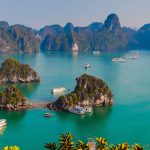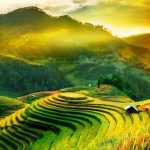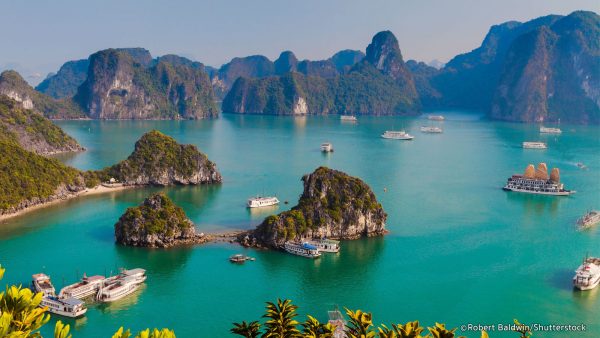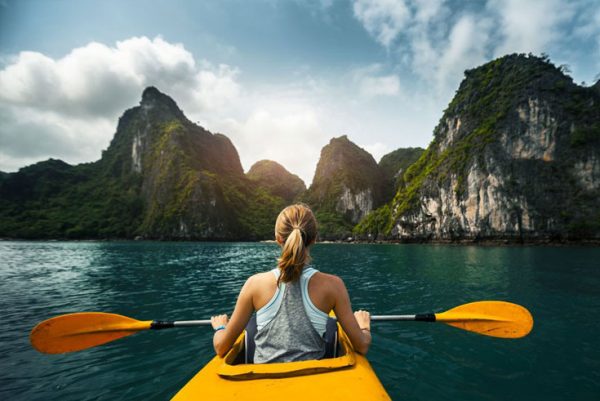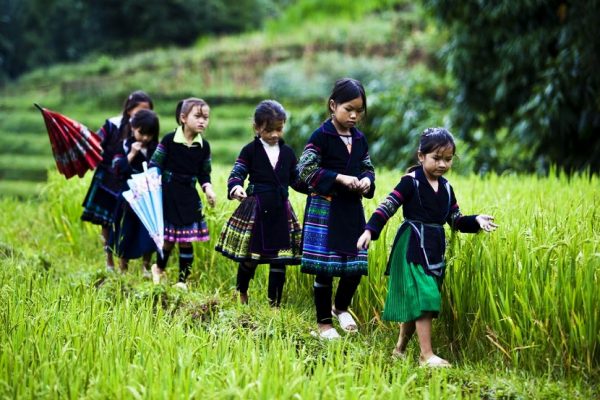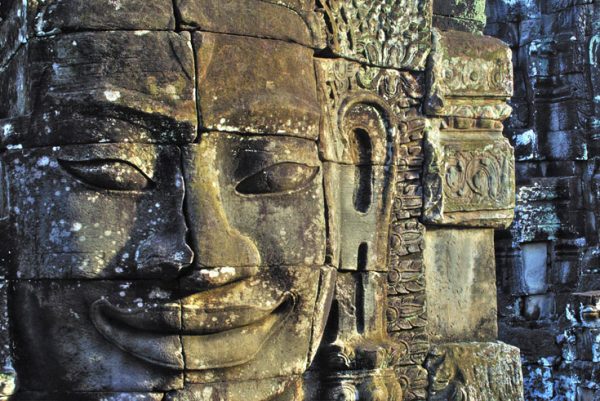Vietnam is one of the top destinations in Southeast Asia, which is really ideal for anyone, who loves natural landscape, quiet trails and even adventurous discovery. Each region in Vietnam gives visitors a different side of this country from culture, tradition to scenery. But certainly, it will not let anyone regret.
Continue reading to find out more about…
Vietnam Travel Facts
Spoken language: Vietnamese (majority of population)
Currency: Vietnam Dong
Population: About 95 million
Politics: The Socialist Republic of Vietnam
Capital: Hanoi
UNESCO World Heritage Site: 8 World Heritage Sites listed by the UNESCO in Vietnam, especially the Phong Nha-Ke Bang National Park is the oldest karst formation in Southeast Asia.
History of Vietnam
Vietnam has a tumultuous history, which pertained to the Chinese, the Khmers, the Chams and the Mongols during the ancient period as well as incidents capturing with Western Nations and American over the 19th century.
Thanks to its rich history, Vietnam has become diverse in culture, tradition, religion and architecture. Leaving dolorous memory behind sine half of former century, Vietnam is on the way to develop economics and the role in the world politics.
Find more details: click here
Culture of Vietnam
Over many centuries, the culture of Vietnam has experience dramatic changes, deeply affecting lifestyle, concepts and values, especially politic ideologies. According to scholarly sources, the culture of Vietnam originated from Nam Viet, an ancient kingdom ò the Baiyue people in East Asia, which had charasteristic similarity to Han Chinese culture and ancient Dong Son Culture. The Dong Son Culture was a Bronze Age in ancient Vietnam at the Red River Valley of Northern Vietnam during 1000 BC and 1st century AD. It has a wide influence on not only Vietnam, but also other parts of Southeast Asia, including Maritime Southeast Asia, from about 1000 BC to 1 BC. To the South of the Dong Son Culture was the Sa Huynh Culture of the proto-Chams.
By 111 BC, Nam Viet was annexed by China, leading to the first Chinese domination of Vietnam lasting over a millennium. Consequently, the Chinese made a big impact on Vietnamese culture in terms of Confucian ideology, governance and the arts.
After regaining independence from China in the 10th century, successive Vietnamese feudal dynasties flourished thanks to southward territory expansion by annexing Champa and Khmer civilizations. It resulted in regional variances of modern-day Vietnamese Culture. After the collapse of feudalism, Vietnam experienced the French colony in the mid-19th century, and gradually absorbed European influences, consisting of architecture, Catholicism, especially the Latin alphabet, which has become origin of Vietnam National Script later, instead of the previous Chinese characters and Chu Nom – Southern Characters.
During the socialist era, Vietnamese culture was mainly affected by cultural exchanges between fellow communist nations such as the Soviet Union, China and Cuba. Following Doi Moi Reform period, Vietnam has continuously an access to plentiful influences from Asian, European and American cultures. But Vietnamese has still remained typical East Asian cultural features such as ancestor veneration and worship, respect for community and family values, and manual labor religious belief. Important cultural symbols in Vietnamese culture include dragons, turtles, lotuses, and bamboo.
Best time to travel to Vietnam
Because of monsoon effects and dramatic differences according to altitude and latitude, Vietnam sees a climate difference among regions: temperature in the southern Vietnam remain stable all year around, while the north experiences distinct seasonal variations. Vietnam can be enjoyed at any time in the year, but in general, Vietnam will have a little rain during dry season from October to April and heavy rain from May to September.
For more information about Vietnam climate & best time to see
Where to go in Vietnam
Northern Vietnam: There is a lot of tourist attractions in the north of Vietnam: from cultural spots to breathtaking natural scenery. Top-raking places in travel bucket list of northern Vietnam are the capital Hanoi, Ninh Binh with Trang An Complex, Ha Long Bay nature wonder and Sapa with Fansipan Peak – the roof top of Indochina.
Central Vietnam: Central Vietnam is famous for beautiful beaches and rich history and culture, even nature masterpieces. Some valued spots here can be named such as Hue – ancient capital in Nguyen Dynasty, Hoi An ancient Town – UNESCO cultural heritage site, Da Nang with beautiful beaches, Bana Hill with Golden Bridge as well as stunning natural landscapes, Nha Trang with beautiful beaches also, Phong Nha – Ke Bang Complex with Son Doong Caves – one of the most outstanding limestone karst ecosystems in the world, etc
Southern Vietnam: Not as many majestic natural landscapes as in Northern and Central Vietnam, south of Vietnam has tourism tendency to the discovery of local lifestyle, culture and history as well as beach vacations. It can be clearly seen in Ho Chi Minh City – the biggest city with French architecture influences, Cu Chi Tunnels, Cao Dai Temple, Da Lat, Mekong Delta, Phan Thiet- Mui Ne, Phu Quoc Island, etc.

Top 10 best places to visit in Vietnam
- Hanoi’s Old Quarters
Vietnam’s capital Hanoi is full of history and culture, especially in the Old Quarters surroundings Hoan Kiem Lake. This is a popular tourist attraction in the city, with bustling market streets, nightlife options, the best Vietnamese Street food, and especially French colonial architecture.
- Trang An Complex in Ninh Binh
Trang An Landscape complex was recognized as a UNESCO World Heritage Site in 2014. It is a spectacular landscape of limestone karst peaks with valleys, caves and vertical cliffs. According to archaeological researches, scientists found out traces of human activities over a constant period of more than 30,000 years. The exploration revealed the appearance of seasonal hunter-gatherers and their adaptation to major climatic and environmental changes, especially after the last ice age, continuing through the Neolithic and Bronze Age to the historical period. The Trang An landscape complex consists of the center of Hoa Lu ancient capital in the north, established in 10th and 11th centuries, Tam Coc – Bich Dong tourist area in the south and Trang An eco-tourism area in the central. These three areas are connected together by Hoa Lu historical and cultural forest on limestone mountains, rivers, lakes and swamps. Trang An area has two main types of ecosystems: limestone mountain ecosystems and aquatic ecosystems. The property also contains temples, pagodas, paddy-fields and small villages
- Ha Long Bay
Ha Long Bay, surrounded by 1,600 limestone islands and islets in an area of over 1,500 sqkm, is one of the UNESCO World Natural Heritage Site in northern Vietnam. Across over 500-million-year formation, Ha Long Bay has been formed with incredible islands, spectacular limestone karsts, fascinating grottos, and natural cave formations, all of them make the surrealistic scenery, voted in the list of Top 15 Most Amazing Landscape and Rock Formations in the world, according to BBC, in 2015. Besides discovering the complex of majestic bay and caves, visitor can enjoy your time with leisure activities such as sunbathing, swimming, kayaking, pearl-farm visiting, fishing village exploration. In the case you prefer adventurous sports, climbing-up or trekking at tough mountains in Cat Bai islands are also attractive activities.
- Hoi An Ancient Town
Located in Quang Nam province, Hoi An is one of the most popular tourist attractions in Central Vietnam, recognized as one World Heritage Site by UNESCO in 1999. To act as an important international port during 17th and 18th century has brought Hoi An a charming harmony of internal and external architecture, especially Chinese and Japanese style, which deeply shown in Covered Japanese Bridge, Phuc Kien Assembly Hall, Ong pagoda, Tan Ky old house, Phung Hung ancient house, etc. Not only historical heritage site, Hoi An is also famous for beautiful beaches and cultural destination, the most well-known one is My Son Holy Land, the ruins of Champa Civilization, which existed from 2nd to 17th century in Vietnam.
- Hue Ancient Capital
Being the royal capital of Vietnam with historical significance during Nguyen Dynasty in 19th century, Hue was recognized a UNESCO cultural heritage site in 1994. It is like a living museum to preserve valued traces, archeological vestiges and many ancient relics. Not only is an ancient land, Hue also own beautiful beaches such as Thuan An, Lang Co, Canh Duong, etc and distinctive cuisine with deeply local culture such as Hue-style beef noodle (Bun Bo Hue), Water Fern Cake (Banh Beo), Rice with mussels (Com Hen), etc. Moreover, Hue is considered as a homeland of intangible heritage named “Nha Nhac of Hue Court” – a Masterpiece of the Oral and Intangible Heritage of Humanity, declared in 2003 by UNESCO.
- My Son Holy Land
My Son Sanctuary was the capital of Cham Pa Kingdom from the 4th to 5th centuries. My Son Holy Land is a large complex of religious monuments with more than original 70 structures, but only 25 monuments of which remain intact today. My Son Sanctuary is the finest example of Cham architecture in Vietnam, which was influenced by India Style and almost temples point to the East, the sun direction with the belief that the East was the place where the Gods lived. Despite being affected seriously due to weather exposure and overgrowth vegetation, their masterpieces still mark a glorious time for the architecture and culture of the Cham and of Southeast Asia. Until now, it still bring its own mysterious secret, that how and by what kind of substance Cham people could stick these red baked bricks together to form such solid structures.
- Phong Nha – Ke Bang National Park
More than a National Park, Phong Nha – Ke Bang is a UNESCO World Heritage Site in Quang Binh province, North – central Vietnam . It is the oldest major karst formation in Asia with the earth crust development 464 millions ago.
Phong Nha – Ke Bang is a 2,000 sqkm of limestone zone and a 70km-length grotto and cave system. It is one of the most important eco-regions of the Indo-Pacific with tropical forests, underground rivers, dry caves and terraced caves as well as many endangers animal species such as black bears, tigers and elephants. Especially, the park is also home to the Son Doong Cave, the world’s largest cave. Coming Phong Nha – Ke Bang National Park, visitors have opportunities to visit caves and grottos by boat, mountain climbing and forest trekking, etc.
- Ho Chi Minh City
Ho Chi Minh City is the most modern city in Vietnam. Not only historical sites, especially French colonial architecture, it is but also a paradise of world- class restaurants, rooftop bars, luxury hotels, street food stalls and as good a nightlife scene as you’ll find anywhere in the region.
- Mekong Delta
Mekong Delta is a charming harmony of dense green rice paddies and lazy, winding rivers, not like any other region in Vietnam. Whether firmly on land or floating on poetic rivers, this region is full of wildlife, historical sights and incredible landscapes. Mekong Delta or The River of Nine Dragons as its local beloved name, is the place the Mekong dividing into nine separate branches, crisscrossing low landscape before entering the sea. Life moves much more slowly here and is often surrounded by water. It is not surprising for visitors to meet homes, farms and markets on an aquatic adaptation in the Mekong Delta.
- Phu Quoc Island
Phu Quoc is the largest tropical island in the 22-island complex of Vietnam in the Gulf of Thailand. It is far 62 sea miles from the east of its own Kien Giang province and only 4 sea miles from the northeast of Cambodia. It is considered a charming pearl of Vietnam because of its incredible natural beauty from beautiful white sandy beaches to a set of lovely islets, interesting discovery activities from culture sites to amazing modern entertainment places. Besides, thanks to magnificent nature of turquoise water and a massive collection of archipelagoes, there are many thrilling water sports in Phu Quoc such as snorkeling, coral diving, squid fishing, etc. In 2006, coastal Biosphere and Kien Giang island waters including Phu Quoc were declared as World Biosphere Reserve by UNESCO.
What to do in Vietnam
Thanks to the terrain diversity, Vietnam can meet the need of any travellers from classic outdoor activities to adventurous ones, from hiking and trekking in majestic mountainous areas such as Ninh Binh, Mai Chau, Sapa to water sports as Scuba diving or snorkeling to discover underwater world in beautiful beaches and islands such as Cu Lao Cham or Phu Quoc Island, from simple going a walk to discover peaceful nooks and crannies of Hanoi, Hoi Chi Minh City and Hoi An Ancient Town to experiencing local lifestyle activities as farming and fishing, buffalo riding, etc to
Vietnamese cuisine is also famous for fresh and healthy ingredients with delicate culinary skills. So joining in a cooking class or street food tour is also very interesting for visitors, especially to try famous food in the world such as Bun Cha, Banh Mi, Pho Thin.
Top 10 Most Interesting Activities in Vietnam

Food and Drink in Vietnam
It is no coincident that Vietnamese cuisine is itself far beyond its borders. It deserves its place by its own unique characteristics with subtle flavors and artistic harmony of using herbs and spices. Another special feature of Vietnamese cuisine is its regional variations. While tasting food in southern Vietnam gives visitors a hint of India and Thailand, especially the French with bread, coffee and ice cream, enjoying northern-style cuisine gives them a savor of Chinese cuisine.
Not only food, drink in Vietnam also expresses Vietnamese typical style, appreciating healthiness. Green tea is typical of Vietnam national beverage, while coffee culture was absorbed from the French. Besides, local beer and rice wine are must-try drinks when anyone come Vietnam.
For more information about Vietnam Food and Drink
How to get to Vietnam
By Bus: there is night bus transfer from Vientiane (Laos) or Phnom Penh, Siem Reap (Cambodia) to Vietnam. It will take from 6 hours to 12 hours for transfer and be suitable for visitors have limited budget or want to experiences
By Flight: Noi Bai International Airport and Tan Son Nhat International Airport are two main international airports in Vietnam, which connect with a lot of airline as well as receive lots of daily external flights in/out Vietnam all around the world. Besides, there are other international airports in Can Tho, Da Nang, Hai Phong, Hue, Nha Trang, Phu Quoc, Quang Ninh, Vinh.
By Cruise: Other interesting way to enter Vietnam is by water way with Mekong Delta Cruise, departing from Laos or Cambodia. Moreover, cruise ships are also luxury style and visitors will enter Vietnam in international sea ports.
Visa Requirement to Vietnam
Most foreigners need to apply for a visa to visit Vietnam, except for some citizens of Asian, England and EU members.
To apply for a Vietnam visa, foreigners can get E-visa or Visa on arrival.
For E-visa: please click here for online application: https://evisa.xuatnhapcanh.gov.vn/trang-chu-ttdt .
For Visa on arrival, clients need to submit below necessary documents:
- Soft Copy of passport with at least 6-month valid
- 2 photos 4*6cm
- Cash of USD25 for stamping fee at airport
- Colorful Print-out of Visa Approval Letter
For more details on Vietnam Visa Requirement: click here

